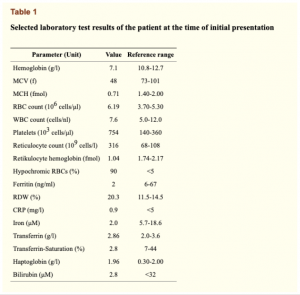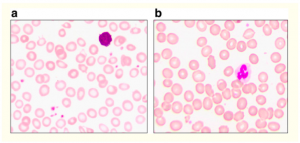This post is adapted for the Health & Medical Case Studies created by the Master of Medical Biotechnology program of the University of Windsor. This work licensed under a Creative Commons Attribution-NonCommercial (CC BY-NC-ND) 4.0 International License.
25 Case 3-2014: A 2.5-year-old boy with anemia and recurrent diarrhea
A two-and-a-half-year-old breastfed toddler presenting with anemia: a case report. BMC Research Notes, 2014, 7(1), 917. https://doi.org/10.1186/1756-0500-7-917
Bock, F., Borucki, K., Vorwerk, P., Biemann, R., & Isermann, B.
Case Summary 1
A 2.5-year-old Turkish boy presented with recurrent diarrhea and vomiting with a history of inadequate nutritional intake. On physical examination, he was weighted 11.5kg which is in between the 3rd and 10th percentile for his age. Anemia and mild dehydration were also present. On lab investigations, blood testing revealed decreased Hb, MCV, and MCH with increased reticulocyte count. His peripheral blood film showed increased hypochromic RBC. A low level of iron and ferritin were detected in the serum iron profile and hemoglobin electrophoresis came out normal. The child was diagnosed and treated accordingly. His condition gradually improved.
Learning Objectives
- Identifying the signs and causes of nutritional anemia in children.
- Recognize the clinical and laboratory findings associated with pediatric anemia.
- Discuss the findings of hemoglobin electrophoresis in thalassemia.
- Familiarizing and defining new medical terminology associated with pediatric anemia.
Clinical History 1
- Age: 2.5 years old
- Sex: Male
- Ethnicity: Turkish
Medical History 1
- No known medical issues.
- According to the information provided by the parents, the patient’s sole source of nutrition was breast milk with a frequency of more than 6 breast-feeds a day and the boy did not receive any food supplements on a regular basis.
Drug History 1
- Not applicable.
Symptoms 1
- Recurrent diarrhea for the last 3 weeks following a family vacation accompanied by vomiting.
Examinations (Clinical Assays/Tests/Imaging) 1
Physical Examination 1
- Weight: 11.5kg
- Nutritional status: Reduced between the 3rd and 10th percentile and carious dentition were apparent.
- Temperature: 99.1F
- Anemia: Present
- Dehydration: Mild with reduced skin turgor but quick recapillarization.
Laboratory Investigations 1
- Blood testing showed moderate-to-severe anemia: decreased Hb with 7.1 g/dl (10.8-12.7), MCV (mean corpuscular volume) of 48 Fl (73–101), MCH (mean corpuscular hemoglobin) of 0.71 fmol.(1.40-2.00), increased RBC count of 6.19 × 106 cells/μl (3.70-5.30) and increased red cell distribution width (RDW) of 20.3% (11.5-14.5), thrombocytosis of 754,000 cells/µl (140–360) and increased reticulocyte count of 316 × 109 cells/l (68–108) with reduced reticulocyte hemoglobin of 1.04 fmol (1.74-2.17).
- Peripheral blood film shows an increase of hypochromic RBCs (90%; Figure 1a)
- Serologic testing also revealed low values for serum-iron of 2 μM (5.7-18.6) and ferritin of 2 ng/ml (6–67) but normal CRP (C-reactive protein) (0.9 mg/l; <5), bilirubin (2.8 μM; <32) and haptoglobin (1.96 g/l; 0.30-2.00) were detected.
- The fecal occult blood test was negative and no pathogenic protozoa, helminths, shigella, yersinia, adeno-, noro-, rota-, astroviruses were found in co-proculture (stool culture).
- Hemoglobin electrophoresis is normal with 96.6% HbA1 (>96.3), 2.7% HbA2 (<3.2) and 0.4% HbF (<0.5).
Chart 1: Laboratory parameters1


Question & Answers Leading to Diagnosis:
Question 1: Based on chief complaints, medical history, physical examinations, what initial diagnosis can we suspect?
Question 2: Which findings in the above lab investigations are confirmatory to reach the final diagnosis?
Question 3: If this patient was experiencing thalassemia, what results would we expect from the hemoglobin electrophoresis?
** For answers please check the next chapter.
Medical terminology/Abbreviations:
- Carious dentition – Dental caries or cavities, more commonly known as tooth decay, are caused by a breakdown of the tooth enamel. This breakdown is the result of bacteria on teeth those breakdown foods and produces acid that destroys tooth enamel and results in tooth decay. 2
- Hypochromic RBC – Hypochromia means that the red blood cells have less color than normal when examined under a microscope. This usually occurs when there is not enough of the pigment that carries oxygen (hemoglobin) in the red blood cells. 3
- Haptoglobin – Haptoglobin is a protein produced by the liver that the body uses to clear free hemoglobin (found outside of red blood cells) from circulation. This test measures the amount of haptoglobin in the blood. 4
- Hemoglobin electrophoresis – Hemoglobin electrophoresis is a test that measures the different types of hemoglobin in the blood. It also looks for abnormal types of hemoglobin. Normal types of hemoglobin include:
- Hemoglobin (Hgb) A, the most common type of hemoglobin in healthy adults
- Hemoglobin (Hgb) F, fetal hemoglobin. This type of hemoglobin is found in unborn babies and newborns. HgbF is replaced by HgbA shortly after birth.5
- MCH – MCH stands for “mean corpuscular hemoglobin.” An MCH value refers to the average quantity of hemoglobin present in a single red blood cell.8
- MCV – MCV stands for mean corpuscular volume. There are three main types of corpuscles (blood cells) in your blood–red blood cells, white blood cells, and platelets. An MCV blood test measures the average size of your red blood cells, also known as erythrocytes. Red blood cells move oxygen from your lungs to every cell in your body. Your cells need oxygen to grow, reproduce and stay healthy. If your red blood cells are too small or too large, it could be a sign of a blood disorder such as anemia, a vitamin deficiency, or other medical condition.7
- RDW – The red cell distribution width (RDW) blood test measures the amount of red blood cell variation in volume and size. Normal red blood cells maintain a standard size of 6 to 8 micrometers (µm) in diameter.6
References
- Bock, F., Borucki, K., Vorwerk, P., Biemann, R., & Isermann, B. (2014). A two-and-a-half-year-old breastfed toddler presenting with anemia: a case report. BMC Research Notes, 7(1), 917. https://doi.org/10.1186/1756-0500-7-917
- Hygiene-related Diseases | Hygiene-related Diseases | Hygiene | Healthy Water | CDC. Cdc.gov. (2021). Retrieved 30 March 2021, from https://www.cdc.gov/healthywater/hygiene/disease/dental_caries.html.
- Encyclopedia, M. (2021). Hypochromia: MedlinePlus Medical Encyclopedia. Medlineplus.gov. Retrieved 30 March 2021, from https://medlineplus.gov/ency/article/003455.htm#:~:text=Hypochromia%20means%20that%20the%20red,in%20the%20red%20blood%20cells.
- Haptoglobin | Lab Tests Online. Labtestsonline.org. (2021). Retrieved 30 March 2021, from https://labtestsonline.org/tests/haptoglobin#:~:text=Haptoglobin%20is%20a%20protein%20produced,transports%20oxygen%20throughout%20the%20body.
- Tests, M. (2021). Hemoglobin Electrophoresis: MedlinePlus Medical Test. Medlineplus.gov. Retrieved 30 March 2021, from https://medlineplus.gov/lab-tests/hemoglobin-electrophoresis/#:~:text=Hemoglobin%20electrophoresis%20is%20a%20test,Hgb)%20F%2C%20fetal%20hemoglobin.
- Red Cell Distribution Width (RDW) Test. Healthline. (2021). Retrieved 30 March 2021, from https://www.healthline.com/health/rdw-blood-test.
- Tests, M. (2021). MCV (Mean Corpuscular Volume): MedlinePlus Medical Test. Medlineplus.gov. Retrieved 30 March 2021, from https://medlineplus.gov/lab-tests/mcv-mean-corpuscular-volume/.
- MCH: High and Low Symptoms and Treatments. Healthline. (2021). Retrieved 30 March 2021, from https://www.healthline.com/health/mch#_noHeaderPrefixedContent.
- Hemoglobin Electrophoresis Patterns in Beta Thalassemia – LabCE.com, Laboratory Continuing Education. Labce.com. (2021). Retrieved 28 May 2021, from https://www.labce.com/spg226480_hemoglobin_electrophoresis__patterns_in_beta_thala.aspx.
Further Reading
Creative Commons License
Dehydration is a lack of total body water, with an accompanying disruption of metabolic processes.
Mange K, Matsuura D, Cizman B, Soto H, Ziyadeh FN, Goldfarb S, Neilson EG (November 1997). "Language guiding therapy: the case of dehydration versus volume depletion". Annals of Internal Medicine. 127 (9): 848–53. doi:10.7326/0003-4819-127-9-199711010-00020. PMID 9382413. S2CID 29854540
MCV stands for mean corpuscular volume. There are three main types of corpuscles (blood cells) in your blood–red blood cells, white blood cells, and platelets. An MCV blood test measures the average size of your red blood cells, also known as erythrocytes. Red blood cells move oxygen from your lungs to every cell in your body. Your cells need oxygen to grow, reproduce and stay healthy. If your red blood cells are too small or too large, it could be a sign of a blood disorder such as anemia, a vitamin deficiency, or other medical condition.
MCH stands for “mean corpuscular hemoglobin.” An MCH value refers to the average quantity of hemoglobin present in a single red blood cell.
Reticulocytes are immature red blood cells (RBCs).
https://en.wikipedia.org/wiki/Reticulocyte
Hypochromia means that the red blood cells have less color than normal when examined under a microscope. This usually occurs when there is not enough of the pigment that carries oxygen (hemoglobin) in the red blood cells.
Hemoglobin electrophoresis is a test that measures the different types of hemoglobin in the blood. It also looks for abnormal types of hemoglobin. Normal types of hemoglobin include:
Hemoglobin (Hgb) A, the most common type of hemoglobin in healthy adults
Hemoglobin (Hgb) F, fetal hemoglobin. This type of hemoglobin is found in unborn babies and newborns. HgbF is replaced by HgbA shortly after birth.
Dental caries or cavities, more commonly known as tooth decay, are caused by a breakdown of the tooth enamel. This breakdown is the result of bacteria on teeth those breakdown foods and produces acid that destroys tooth enamel and results in tooth decay.
The restoration of a network of capillaries to a part of the body
https://en.wiktionary.org/wiki/recapillarization
The red cell distribution width (RDW) blood test measures the amount of red blood cell variation in volume and size. Normal red blood cells maintain a standard size of 6 to 8 micrometers (µm) in diameter.
Thrombocytosis (throm-boe-sie-TOE-sis) is a disorder in which your body produces too many platelets.
https://www.mayoclinic.org/diseases-conditions/thrombocytosis/symptoms-causes/syc-20378315#:~:text=Thrombocytosis%20(throm%2Dboe%2Dsie,condition%2C%20such%20as%20an%20infection.
Haptoglobin is a protein produced by the liver that the body uses to clear free hemoglobin (found outside of red blood cells) from circulation. This test measures the amount of haptoglobin in the blood.
Protozoa (singular protozoon or protozoan, plural protozoa or protozoans) is an informal term for a group of single-celled eukaryotes, either free-living or parasitic, that feed on organic matter such as other microorganisms or organic tissues and debris
https://en.wikipedia.org/wiki/Protozoa
Parasitic worms, also known as helminths, are large macroparasites; adults can generally be seen with the naked eye.
https://www.cdc.gov/parasites/about.html
Shigella is a genus of bacteria that is Gram-negative, facultative anaerobic, non-spore-forming, nonmotile, rod-shaped, and genetically closely related to E. coli.
https://en.wikipedia.org/wiki/Shigella
Yersinia is a genus of bacteria in the family Yersiniaceae
https://en.wikipedia.org/wiki/Yersinia


